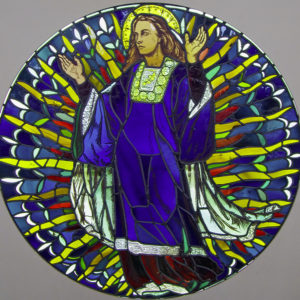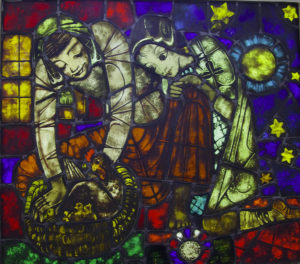Stained glass windows are the glory of many of our churches , flooding the building with coloured light on sunny days.
We take the stained glass for granted and it is often difficult to see and appreciate the detail and complexity of the glass. “The Stained Glass Museum”:http://wasleys.org.uk/eleanor/churches/england/cambridgeshire/ely/ely_ten/index.html in Ely Cathedral is the only Museum in Britain dedicated to Stained glass and one of a few places in the world covering such a large chronological span of stained glass. It contains over 100 panels dating from the early C13th to the mid C20th of both religious and secular glass. These are displayed at eye level and carefully illuminated from behind. You can really get up close and personal with the glass.
The Museum in in the south east triforium of the Cathedral and reached up a steep stone spiral staircase. As well as the stained glass panels, there are information boards covering the development of stained glass and a collection of tools and materials used in the design and manufacture of stained glass. It also has a collection of preparatory designs, cartoons and maquettes relating to C19th and C20th glass which are sometimes part of temporary displays. It also has a reference library for research workers and a very good shop.
Some of the stained glass on display is beautiful. I was perhaps a little disappointed that there was less medieval glass than C19th and C20th glass.
Like wall paintings, the purpose of the stained glass windows in churches and cathedrals was to tell the stories of the Bible and the life of saints to a largely illiterate congregation. Much of the stained glass was paid for by donors who hoped it would buy them a place in Heaven. The windows often contained an image of them.
The early stained glass known as grisaille was painted in shades of grey and one of the best examples of this can be seen in the C13th Five Sisters window in the “north transept of York Minster.”:http://wasleys.org.uk/eleanor/churches/england/yorkshire/north_yorkshire/york/york_1/minster/minster_three/index.html This is one of the largest expanses of Grisaille glass to survive in the world.
Brightly coloured glass was imported from glass makers in Normandy and the Rhinelands but was very expensive. Most of the brightly coloured stained glass windows from that date are found in Europe, like this panel dated about 1210 from Soisson Cathedral in France.
From about 1310 yellow staining allowed white glass to be richly decorated and this became popular, especially as small roundels mounted in larger plain glass windows. There are excellent examples of these in “King’s College Chapel”:http://wasleys.org.uk/eleanor/churches/england/cambridgeshire/cambridge_kings/kings_three/index.html Cambridge. The lovely shades of yellow and brown in these roundels was achieved by staining the back of the glass with a silver compound before firing in the kiln.
From the early 1500s, coloured glass became more readily available and cheaper. Stained glass windows appeared in churches and cathedrals. Little stained glass survives as it was destroyed during the Reformation and later Commonwealth. The best places to see Medieval glass are “Canterbury Cathedral,”:http://wasleys.org.uk/eleanor/churches/england/south/southeast/canterbury/index.html
“King’s College, Cambridge,”:http://wasleys.org.uk/eleanor/churches/england/cambridgeshire/cambridge_kings/index.html “Great Malvern Priory, Worcestershire,”:http://wasleys.org.uk/eleanor/churches/england/west_midlands/worcestershire/great_malvern/index.html “Long Melford Church, Suffolk”:http://wasleys.org.uk/eleanor/churches/england/suffolk/suffolk_two/long_melford/index.html and “Fairfax Church, Gloucestershire”:http://wasleys.org.uk/eleanor/churches/england/cotswolds/gloucestershire/gloucestershire_two/fairford/index.html Some of the colours are surprisingly vivid even today.
There was little interest in stained glass between 1600-1800 but it became increasingly in demand when the Industrial Revolution resulted in a rapid expansion of towns and cities and a demand for new churches. Roman Catholics were allowed to worship freely from 1829,, boosting the demand for new churches. Many existing churches were in a poor state of repair by the C19th and needed restoring. Stained glass was used when funds allowed.
Early C19th stained glass was often thin and garish. This resulted in leading architects like Pugin to encourage experimentation in production techniques and colouring of the glass. The best C19th stained glass was now the equal of C16th stained glass. Some of the best glass came from the workshops of CE Kempe, Clayton and Bell and Burlison and Grylls.
As well as designing textiles, tiles and furniture, people like William Morris and Edward Burne Jones also produced designs for stained glass windows. The began using slab glass. This had a slightly uneven surface which gave the colour an exceptional intensity and jewel like quality.
The end of the Second World War led to a demand for memorial windows and provided work for the great Victorian workshops into the 1950s. Stained glass continues to be as popular as ever with new designers producing modern designs.
The museum is open daily except on Good Friday, Christmas Day and Boxing Day from 10.30-5.30 and 12-4.30 on Sundays. If visiting the cathedral, it makes sense to buy a joint ticket from the Cathedral admissions desk. Unfortunately there is no disabled access although a touch screen virtual visit is available on the ground floor.
It is also a rare chance to visit the triforium in a cathedral. Seen from below these always look like narrow passageway. In fact they are quite wide and there is a lot of space. There are also very good views of the painted nave ceiling and the painted ceiling of the south west tower.
There are photographs with notes about the different examples of stained glass “here.”:http://wasleys.org.uk/eleanor/churches/england/cambridgeshire/ely/ely_ten/index.html
“Website”:http://stainedglassmuseum.com/










